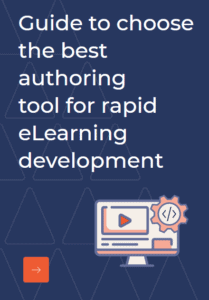There are roughly 800+ eLearning companies across the world and each company is associated with 20’s to 50’s of other organization. Let’s assume that each company gets at least one eLearning project created each year. That would add up to approximately 40,000 eLearning courses/modules each year (kindly forgive if the math is wrong! Just creating a broad picture here). So, what happens when the companies decide to change vendors, or Learning management systems? What do they do with the existing eLearning? Oh, they do not trash it- after all each course does cost-time & money.
To avoid such desperate measures, and to ensure that the eLearning created meets some quality standards, there are some global eLearning standards that have been created by some eminent bodies.
ASTD groups the standards into four categories: Interface Standards, Compatibility Standards, Production Quality Standards, and Instructional Design Standards. Though there are other attempts to create guidelines too like ISO/IEC, the ASTD guidelines are quite popular.
In this blog, we focus on an aspect that defines the overall look and feel of eLearning, Interface Standards. It addresses the relationship between the learner and the course ware and are divided into 5 parts.
1- Orientation Display
For an eLearning, one of the important aspect is to have orientation display features that are not just dummy and function properly. And what are these? These are nothing but menu function, topic listing, slide numbering etc. seen in most eLearning courses. The ASTD criteria and scoring for this standard is based on four aspects, the total score adding up to 9, but the passing score for this is 7. The four aspects include- labeling of the orientation display features, consistency in position and functioning, and its ability to allow the learners to understand their current location within the course.
This standard is quite in congruence with the user interface guidelines for web app or most software's, where it is clearly stated that the UI elements should be applied in the way they are originally defined.
2- Tracking
It is important to know the progress of the learner, both for the learners benefit and the instructors too. Usually this is done by changing the color of the topic indicator, check boxes, video sliders, percentage representation etc. The Total score according to ASTD is 12 and the cut-off is 9. In includes- labeling of the tracking features, consistence in position and functionality, accuracy in tracking, indication of partial completion too as and where possible.
3- Navigation Functiontionalities
This standard basically covers everything from start, next-back, forward- backward and eventually exit. In general UI design, developers and designers try to use the commonly used locations for various graphical elements such as having the logo on the top left, search field on the top right, exit icon on the top right, etc. for incorporating the navigation buttons or settings.
ASTD scores this to 15 points and a cut off of 12 for certification. It covers the ease of use, predictability of functions and most importantly the presence of start, forward, backward, save, exit and return function and also that these functions do not in any way overlap or interfere with browser buttons (if applicable). Today’s smart authoring tools do offer a great flexibility to customize the navigations and make it more user friendly.
4- Additional/Optional Functions
Optional functions are additional or extra functions that are can add depth to the learning process. For instance, allowing the learners to save or bookmark certain areas of a course to refer to it in the future, or even take a snapshot for that matter can be considered an optional function. The standards guideline scores this at a maximum of 9 with 6 as cut-off. The scores depend on the presence, the functionability, the positioning, the ease of use and also on how optimized the resource usage is in relation to a particular function.
5- Operational Support
As the name suggests it is to support the operations and to make it easy for the learners to access and learn from a course. These days almost every software comes with automated responses that take the user through a self-learning process at installing, and even using it. So, should be the case with learning that we design. It is scored at 12 points with a cut-off of 10, which means the requirement is pretty high.
The scoring depends on the presence of such function, the ease of use and positioning, its functioning, its ability to assist with navigation, technical issues and also with special or proprietary course functions (if applicable).
If you have been creating eLearning without considering these standards, its time you start doing so. Try incorporating the elements and rest assured you will see an evident difference in the kind of eLearning output you get. And if you prefer using authoring tools then you are at luck as most of the templates available do abide by the standards mostly- unless you decide to do a lot of high end customizations.
The Knowzies Learning Development team pays close attention to the above-mentioned details, to create world class eLearning and to assist you with your eLearning design requirements too. We would like to invite you to our eLearning portfolio at Knowzies Portfolio



